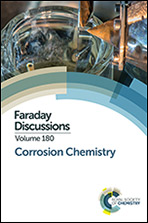Understanding corrosion inhibition with van der Waals DFT methods: the case of benzotriazole
Abstract
The corrosion of materials is an undesirable and costly process affecting many areas of technology and everyday life. As such, considerable effort has gone into understanding and preventing it. Organic molecule based coatings can in certain circumstances act as effective corrosion inhibitors. Although they have been used to great effect for more than sixty years, how they function at the atomic-level is still a matter of debate. In this work, computer simulation approaches based on density functional theory are used to investigate benzotriazole (BTAH), one of the most widely used and studied corrosion inhibitors for copper. In particular, the structures formed by protonated and deprotonated BTAH molecules on Cu(111) have been determined and linked to their inhibiting properties. It is found that hydrogen bonding, van der Waals interactions and steric repulsions all contribute in shaping how BTAH molecules adsorb, with flat-lying structures preferred at low coverage and upright configurations preferred at high coverage. The interaction of the dehydrogenated benzotriazole molecule (BTA) with the copper surface is instead dominated by strong chemisorption via the azole moiety with the aid of copper adatoms. Structures of dimers or chains are found to be the most stable structures at all coverages, in good agreement with scanning tunnelling microscopy results. Benzotriazole thus shows a complex phase behaviour in which van der Waals forces play an important role and which depends on coverage and on its protonation state and all of these factors feasibly contribute to its effectiveness as a corrosion inhibitor.
- This article is part of the themed collections: Corrosion Chemistry, Celebrating our 2020 Prize and Award winners and Celebrating the 2016 RSC Prize and Award Winners

 Please wait while we load your content...
Please wait while we load your content...